Sixun Dong
Michael
MMTok: Multimodal Coverage Maximization for Efficient Inference of VLMs
Aug 25, 2025Abstract:Vision-Language Models (VLMs) demonstrate impressive performance in understanding visual content with language instruction by converting visual input to vision tokens. However, redundancy in vision tokens results in the degenerated inference efficiency of VLMs. While many algorithms have been proposed to reduce the number of vision tokens, most of them apply only unimodal information (i.e., vision/text) for pruning and ignore the inherent multimodal property of vision-language tasks. Moreover, it lacks a generic criterion that can be applied to different modalities. To mitigate this limitation, in this work, we propose to leverage both vision and text tokens to select informative vision tokens by the criterion of coverage. We first formulate the subset selection problem as a maximum coverage problem. Afterward, a subset of vision tokens is optimized to cover the text tokens and the original set of vision tokens, simultaneously. Finally, a VLM agent can be adopted to further improve the quality of text tokens for guiding vision pruning. The proposed method MMTok is extensively evaluated on benchmark datasets with different VLMs. The comparison illustrates that vision and text information are complementary, and combining multimodal information can surpass the unimodal baseline with a clear margin. Moreover, under the maximum coverage criterion on the POPE dataset, our method achieves a 1.87x speedup while maintaining 98.7% of the original performance on LLaVA-NeXT-13B. Furthermore, with only four vision tokens, it still preserves 87.7% of the original performance on LLaVA-1.5-7B. These results highlight the effectiveness of coverage in token selection.
Complex Logical Instruction Generation
Aug 12, 2025Abstract:Instruction following has catalyzed the recent era of Large Language Models (LLMs) and is the foundational skill underpinning more advanced capabilities such as reasoning and agentic behaviors. As tasks grow more challenging, the logic structures embedded in natural language instructions becomes increasingly intricate. However, how well LLMs perform on such logic-rich instructions remains under-explored. We propose LogicIFGen and LogicIFEval. LogicIFGen is a scalable, automated framework for generating verifiable instructions from code functions, which can naturally express rich logic such as conditionals, nesting, recursion, and function calls. We further curate a collection of complex code functions and use LogicIFGen to construct LogicIFEval, a benchmark comprising 426 verifiable logic-rich instructions. Our experiments demonstrate that current state-of-the-art LLMs still struggle to correctly follow the instructions in LogicIFEval. Most LLMs can only follow fewer than 60% of the instructions, revealing significant deficiencies in the instruction-following ability. Code and Benchmark: https://github.com/mianzhang/LogicIF
LLM-ML Teaming: Integrated Symbolic Decoding and Gradient Search for Valid and Stable Generative Feature Transformation
Jun 10, 2025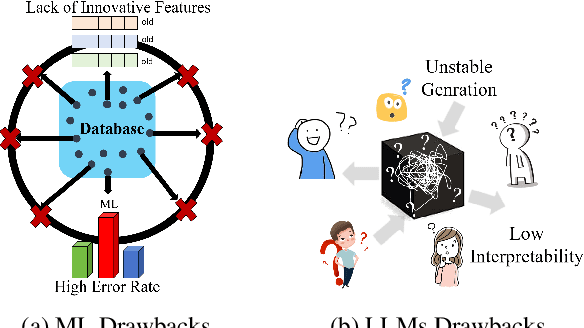

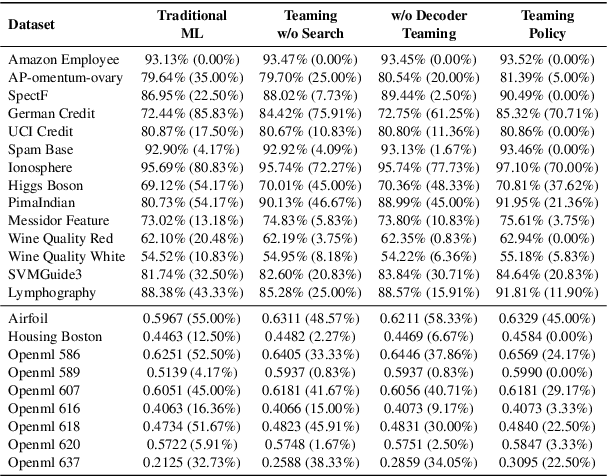
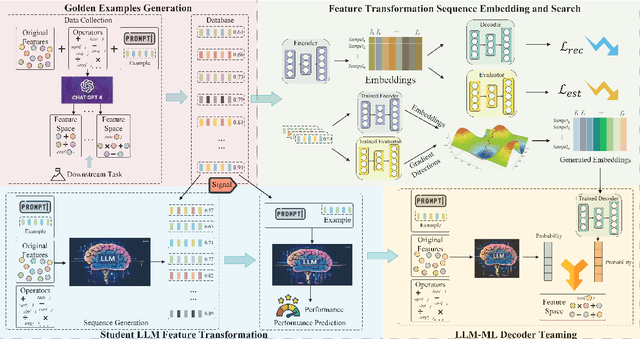
Abstract:Feature transformation enhances data representation by deriving new features from the original data. Generative AI offers potential for this task, but faces challenges in stable generation (consistent outputs) and valid generation (error-free sequences). Existing methods--traditional MLs' low validity and LLMs' instability--fail to resolve both. We find that LLMs ensure valid syntax, while ML's gradient-steered search stabilizes performance. To bridge this gap, we propose a teaming framework combining LLMs' symbolic generation with ML's gradient optimization. This framework includes four steps: (1) golden examples generation, aiming to prepare high-quality samples with the ground knowledge of the teacher LLM; (2) feature transformation sequence embedding and search, intending to uncover potentially superior embeddings within the latent space; (3) student LLM feature transformation, aiming to distill knowledge from the teacher LLM; (4) LLM-ML decoder teaming, dedicating to combine ML and the student LLM probabilities for valid and stable generation. The experiments on various datasets show that the teaming policy can achieve 5\% improvement in downstream performance while reducing nearly half of the error cases. The results also demonstrate the efficiency and robustness of the teaming policy. Additionally, we also have exciting findings on LLMs' capacity to understand the original data.
Efficient Post-Training Refinement of Latent Reasoning in Large Language Models
Jun 10, 2025



Abstract:Reasoning is a key component of language understanding in Large Language Models. While Chain-of-Thought prompting enhances performance via explicit intermediate steps, it suffers from sufficient token overhead and a fixed reasoning trajectory, preventing step-wise refinement. Recent advances in latent reasoning address these limitations by refining internal reasoning processes directly in the model's latent space, without producing explicit outputs. However, a key challenge remains: how to effectively update reasoning embeddings during post-training to guide the model toward more accurate solutions. To overcome this challenge, we propose a lightweight post-training framework that refines latent reasoning trajectories using two novel strategies: 1) Contrastive reasoning feedback, which compares reasoning embeddings against strong and weak baselines to infer effective update directions via embedding enhancement; 2) Residual embedding refinement, which stabilizes updates by progressively integrating current and historical gradients, enabling fast yet controlled convergence. Extensive experiments and case studies are conducted on five reasoning benchmarks to demonstrate the effectiveness of the proposed framework. Notably, a 5\% accuracy gain on MathQA without additional training.
Bridging the Domain Gap in Equation Distillation with Reinforcement Feedback
May 21, 2025

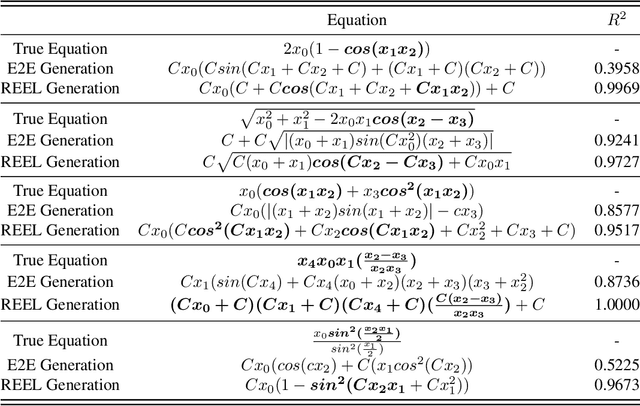
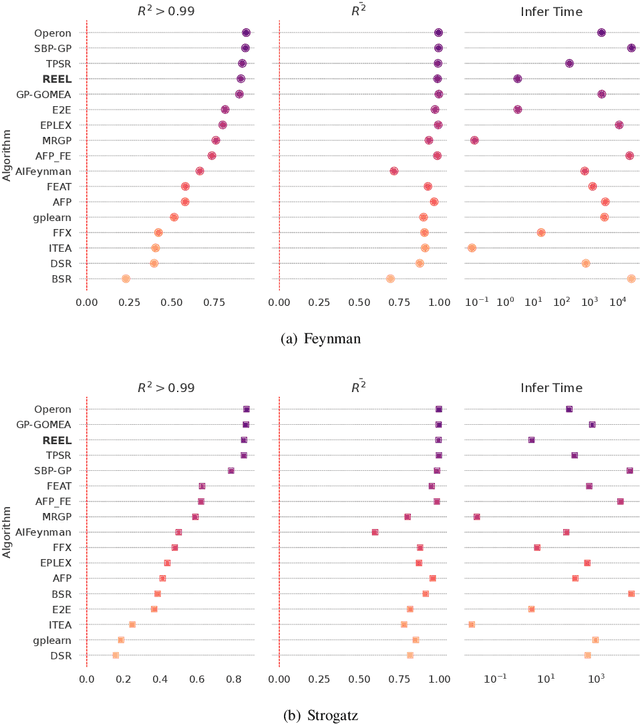
Abstract:The data-to-equation (Data2Eqn) task aims to discover interpretable mathematical equations that map observed values to labels, offering physical insights and broad applicability across academic and industrial domains. Genetic programming and traditional deep learning-based approaches suffer from search inefficiency and poor generalization on small task-specific datasets. Foundation models showed promise in this area, but existing approaches suffer from: 1) They are pretrained on general-purpose data distributions, making them less effective for domain-specific tasks; and 2) their training objectives focus on token-level alignment, overlooking mathematical semantics, which can lead to inaccurate equations. To address these issues, we aim to enhance the domain adaptability of foundation models for Data2Eqn tasks. In this work, we propose a reinforcement learning-based finetuning framework that directly optimizes the generation policy of a pretrained model through reward signals derived from downstream numerical fitness. Our method allows the model to adapt to specific and complex data distributions and generate mathematically meaningful equations. Extensive experiments demonstrate that our approach improves both the accuracy and robustness of equation generation under complex distributions.
Agentic Feature Augmentation: Unifying Selection and Generation with Teaming, Planning, and Memories
May 21, 2025Abstract:As a widely-used and practical tool, feature engineering transforms raw data into discriminative features to advance AI model performance. However, existing methods usually apply feature selection and generation separately, failing to strive a balance between reducing redundancy and adding meaningful dimensions. To fill this gap, we propose an agentic feature augmentation concept, where the unification of feature generation and selection is modeled as agentic teaming and planning. Specifically, we develop a Multi-Agent System with Long and Short-Term Memory (MAGS), comprising a selector agent to eliminate redundant features, a generator agent to produce informative new dimensions, and a router agent that strategically coordinates their actions. We leverage in-context learning with short-term memory for immediate feedback refinement and long-term memory for globally optimal guidance. Additionally, we employ offline Proximal Policy Optimization (PPO) reinforcement fine-tuning to train the router agent for effective decision-making to navigate a vast discrete feature space. Extensive experiments demonstrate that this unified agentic framework consistently achieves superior task performance by intelligently orchestrating feature selection and generation.
Brownian Bridge Augmented Surrogate Simulation and Injection Planning for Geological CO$_2$ Storage
May 21, 2025
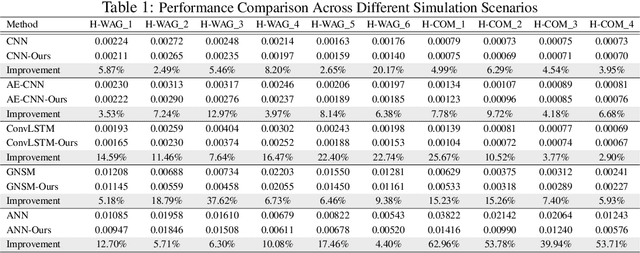


Abstract:Geological CO2 storage (GCS) involves injecting captured CO2 into deep subsurface formations to support climate goals. The effective management of GCS relies on adaptive injection planning to dynamically control injection rates and well pressures to balance both storage safety and efficiency. Prior literature, including numerical optimization methods and surrogate-optimization methods, is limited by real-world GCS requirements of smooth state transitions and goal-directed planning within limited time. To address these limitations, we propose a Brownian Bridge-augmented framework for surrogate simulation and injection planning in GCS and develop two insights: (i) Brownian bridge as a smooth state regularizer for better surrogate simulation; (ii) Brownian bridge as goal-time-conditioned planning guidance for improved injection planning. Our method has three stages: (i) learning deep Brownian bridge representations with contrastive and reconstructive losses from historical reservoir and utility trajectories, (ii) incorporating Brownian bridge-based next state interpolation for simulator regularization, and (iii) guiding injection planning with Brownian utility-conditioned trajectories to generate high-quality injection plans. Experimental results across multiple datasets collected from diverse GCS settings demonstrate that our framework consistently improves simulation fidelity and planning effectiveness while maintaining low computational overhead.
Sculpting Features from Noise: Reward-Guided Hierarchical Diffusion for Task-Optimal Feature Transformation
May 21, 2025



Abstract:Feature Transformation (FT) crafts new features from original ones via mathematical operations to enhance dataset expressiveness for downstream models. However, existing FT methods exhibit critical limitations: discrete search struggles with enormous combinatorial spaces, impeding practical use; and continuous search, being highly sensitive to initialization and step sizes, often becomes trapped in local optima, restricting global exploration. To overcome these limitations, DIFFT redefines FT as a reward-guided generative task. It first learns a compact and expressive latent space for feature sets using a Variational Auto-Encoder (VAE). A Latent Diffusion Model (LDM) then navigates this space to generate high-quality feature embeddings, its trajectory guided by a performance evaluator towards task-specific optima. This synthesis of global distribution learning (from LDM) and targeted optimization (reward guidance) produces potent embeddings, which a novel semi-autoregressive decoder efficiently converts into structured, discrete features, preserving intra-feature dependencies while allowing parallel inter-feature generation. Extensive experiments on 14 benchmark datasets show DIFFT consistently outperforms state-of-the-art baselines in predictive accuracy and robustness, with significantly lower training and inference times.
Unsupervised Feature Transformation via In-context Generation, Generator-critic LLM Agents, and Duet-play Teaming
Apr 30, 2025



Abstract:Feature transformation involves generating a new set of features from the original dataset to enhance the data's utility. In certain domains like material performance screening, dimensionality is large and collecting labels is expensive and lengthy. It highly necessitates transforming feature spaces efficiently and without supervision to enhance data readiness and AI utility. However, existing methods fall short in efficient navigation of a vast space of feature combinations, and are mostly designed for supervised settings. To fill this gap, our unique perspective is to leverage a generator-critic duet-play teaming framework using LLM agents and in-context learning to derive pseudo-supervision from unsupervised data. The framework consists of three interconnected steps: (1) Critic agent diagnoses data to generate actionable advice, (2) Generator agent produces tokenized feature transformations guided by the critic's advice, and (3) Iterative refinement ensures continuous improvement through feedback between agents. The generator-critic framework can be generalized to human-agent collaborative generation, by replacing the critic agent with human experts. Extensive experiments demonstrate that the proposed framework outperforms even supervised baselines in feature transformation efficiency, robustness, and practical applicability across diverse datasets.
A Survey on Data-Centric AI: Tabular Learning from Reinforcement Learning and Generative AI Perspective
Feb 12, 2025


Abstract:Tabular data is one of the most widely used data formats across various domains such as bioinformatics, healthcare, and marketing. As artificial intelligence moves towards a data-centric perspective, improving data quality is essential for enhancing model performance in tabular data-driven applications. This survey focuses on data-driven tabular data optimization, specifically exploring reinforcement learning (RL) and generative approaches for feature selection and feature generation as fundamental techniques for refining data spaces. Feature selection aims to identify and retain the most informative attributes, while feature generation constructs new features to better capture complex data patterns. We systematically review existing generative methods for tabular data engineering, analyzing their latest advancements, real-world applications, and respective strengths and limitations. This survey emphasizes how RL-based and generative techniques contribute to the automation and intelligence of feature engineering. Finally, we summarize the existing challenges and discuss future research directions, aiming to provide insights that drive continued innovation in this field.
 Add to Chrome
Add to Chrome Add to Firefox
Add to Firefox Add to Edge
Add to Edge